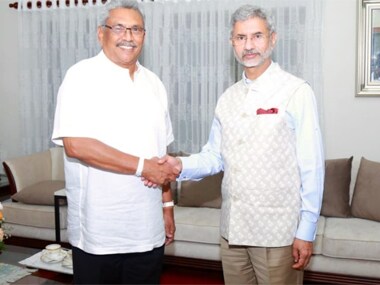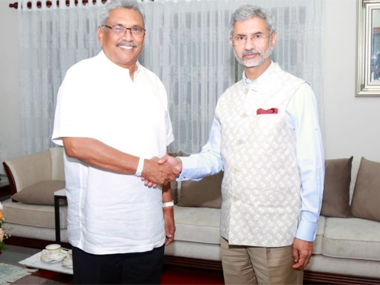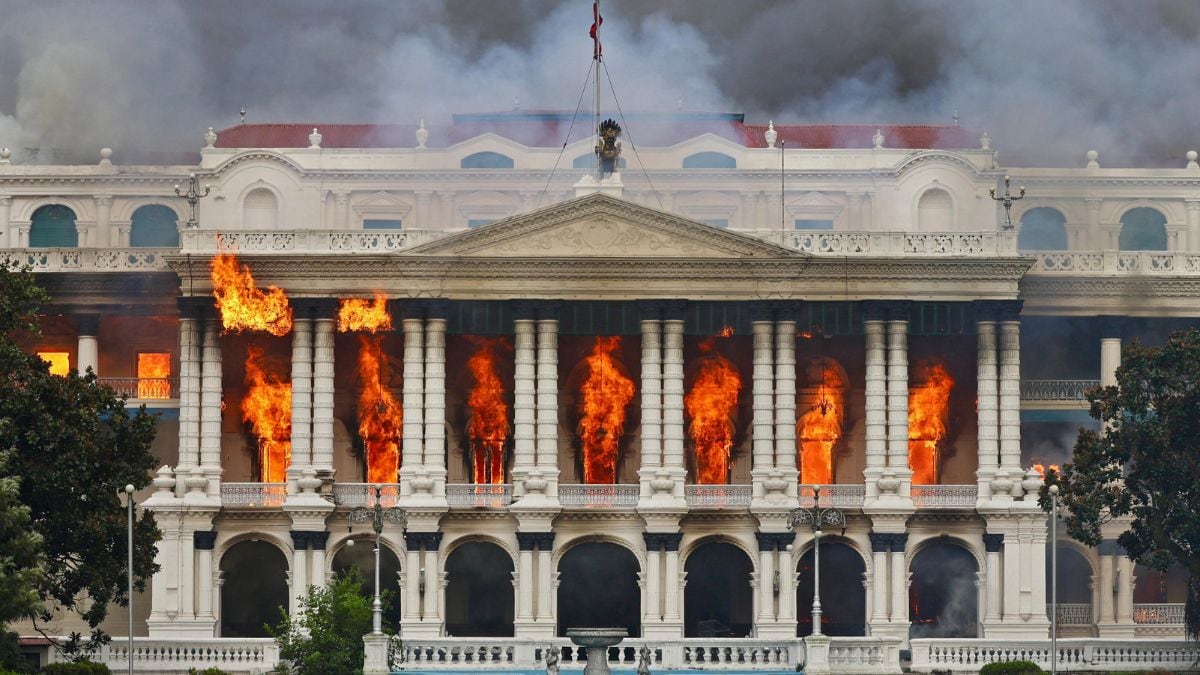No sooner did Gotabaya Rajapaksa emerge as the winner in Sri Lanka’s presidential elections that the narrative about “China would be happy” was set. Commentators expressed fears that Colombo will swing back to Beijing once again leaving India and the US in the cold. Following the ‘pro-China’ security and economic policies of Mahinda Rajapaksa that left Sri Lanka reeling under debt, the coalition government of president Maithripala Sirisena and prime minister Renil Wickremasinghe was elected in the backdrop of mounting concerns in the island nation against Chinese investments. Sirisena in 2015 had warned during his campaign that if (Mahinda) Rajapaksa’s policies continued for another six years, Sri Lanka would “become a colony, and we would become slaves”. As another member of the powerful Rajapaksa family now takes charge, one analyst was quoted on Sunday by Reuters as saying that the return of the Rajapaksa clan may result in “a pivot toward China once again. China is likely very happy that Gota has won.” In India, Gotabaya’s victory on the back of a resounding mandate has largely been interpreted as a “setback”. Memories of Mahinda — former president (2005-2015), brother of the incumbent and now a likely prime ministerial candidate — blaming Indian intelligence agency for his shock defeat in the 2015 elections are still fresh. India’s alleged machinations, which New Delhi has vehemently denied, was thought to have been the result of Mahinda crossing a number of New Delhi’s red lines including allowing Chinese nuclear submarines to dock at Sri Lanka’s port and throwing an unacceptable maritime security challenge to India. [caption id=“attachment_7677351” align=“alignleft” width=“380”]  Sri Lankan president Gotabaya Rajapaksa with External Affairs Minister S Jaishankar. Image courtesy Twitter handle of @DrSJaishankar[/caption] As Devirupa Mitra recounts the lack of trust between India and Sri Lanka under Mahinda’s reign in The Wire: “When Narendra Modi became prime minister, (Mahinda) Rajapaksa had already been president for nine years. There was rising concern over the Rajapaksa brothers’ red-carpet welcome to China, with Beijing bagging contracts from the north to south to build power plants, ports, airports, road and rail infrastructure. This was coupled with the perception that Mahinda Rajapaksa had become “arrogant” due to his longevity at the helm. It was the visit of Chinese submarines to Colombo port which finally made the Modi government lose its patience.” Quite naturally, the headlines in India have been alarming. While some wondered whether “ Gotabaya will make peace with India” others pointed out that “ concerns remain over Rajapaksa’s China links”. The fear of Lanka tilting China’s way once again is quite pronounced. The reality is a little more complex than assuming that Sri Lanka will swing like a pendulum between India and China. There is no denying that the strategic location of Sri Lanka — straddling vital sea lanes and being at the centre of Indian Ocean Region in a space India considers as its strategic backyard — exposes it to the risk of being a pawn in the great game of big powers. But there is an inherent risk in assuming that even small states with limited resources and hedging strategies are completely bereft of an agency or are oblivious to the benefits of pursuing a realist policy. Neither was the government of Sirisena and Wickremasinghe “anti-China” and “pro-India” nor should we expect Gotabaya to do the exact opposite. In his manifesto and during campaigning, Gotabaya promised to arbitrate anew the terms of the Hambantota port that has been leased to the Chinese for 99 years under conditions that make China’s “debt-trap” a stark reality, and he has also vowed to maintain strategic equidistance from Asian giants. If the principle of hard realism dictates that small states follow rules-based order and multilateral engagement, then Gotabaya is more likely to lean towards a hedging strategy between India and China and balance one against the other. It is also erroneous to assume, as some media commentaries reflexively do, that under Sirisena and Wickremasinghe, Sri Lanka was “pro-India”. It is worth noting that the port of Hambantota — a few hundred miles off Indian shores — was leased to the Chinese in 2018 under the coalition government though it is fair to point out that by then Sri Lanka was struggling to repay the debts Mahinda had taken. However, it is equally true, as C Raja Mohan, director of National University of Singapore points out, “the outgoing coalition led by President Maithripala Sirisena and Prime Minister Ranil Wickremesinghe… came to power criticising the Chinese projects in Sri Lanka as financially unsustainable. Two years into power, the coalition extended full backing to the Chinese projects. It was this so-called “pro-India” regime that offered China a 99-year lease on the Hambantota project. To add insult to injury, the “pro-India” government stalled key projects of interest to Delhi.” These caveats apart, India does face a challenge in its immediate neighbourhood with a China-friendly government in Nepal, hostile adversary to the west in the form of Pakistan that is now little more than a Chinese satellite and a hard realist down south in Sri Lanka. As strategic thinker Brahma Chellaney has pointed out, the very fact that Gotabaya has promised strategic equidistance from China and India must be taken as a “setback” of sorts since countries such as Nepal and Lanka are considered to be an inalienable part of greater Indian civilisation.
As a policy, we will maintain an equi-distant and yet, cordial relations with all countries and remain neutral in the power struggles amongst nations. I also appeal to all global leaders, to respect the sovereignty and unitary status of Sri Lanka pic.twitter.com/GoSFrS6Yk0
— Gotabaya Rajapaksa (@GotabayaR) November 18, 2019
Sri Lanka, like many other south Asian nations, is hungry for investment and reliant on loans for economic growth and upliftment of its people. To quote Palitha Kohona, former foreign secretary considered close to the Rajapaksa clan, “we are in a hurry to develop (the country). Anyone can invest here. If our first priority is to maintain a special relationship with India, we are also prioritising our trade and investment relationships with every potential partner, such as China or US or European countries.” The problem is that as China comes courting the nations that India considers to be part of its civilisational orbit and symbiotically tied to its strategic interests, New Delhi cannot hope to match the scope, scale and sheer economic muscle of China in extending loans and its speed in executing large-scale infrastructure projects. China has, in recent times, making rapid strategic and security investments in the nations that share maritime borders with India. In July, for instance, China donated a frigate to the Sri Lankan Navy that was equipped with dual Type 79 100 mm cannons and two Type 76A dual-37 mm Anti-Aircraft Guns. The vessel, according to scholar Rajeswari Pillai Rajagopalan in The Diplomat, also has a helipad and hangar to store and operate a medium-size helicopter. In addition, the PLA-N (Chinese navy) conducted a two-month professional training for more than 110 Sri Lankan naval officers and sailors in Shanghai. She also points out that in May, “China decided to provide Sri Lanka with $14 million to procure Chinese counterinsurgency equipment.” Besides the fact that China-Lanka’s military cooperation has deepened with Mahinda’s 2007 visit to Beijing — that paved the way for large cache of arms supply and high-level security engagement — India has been worried over speculation that China may build a aircraft maintenance facility in the eastern port city of Trincomalee, which India considers a strategic location in national security terms. To counter this deepening economic and security embrace, India under the Narendra Modi government has increasingly been relying on energetic diplomacy, taking a pragmatic view of Chinese investments and highlighting the shared culture, civilisational ties and proximity of geography. In a visit to Sri Lanka in 2017 — a nation that Modi considers as a cornerstone of India’s “neighbourhood first” policy — the prime minister had written on Facebook that “My visit brings to the fore one of the most abiding links between India and Sri Lanka- the shared heritage of Buddhism.” Notably, India has been first off the blocks to extend an invitation to Gotabaya which the new Sri Lankan president has accepted. Also, just a day after he was sworn in, India’s External Affairs Minister Subramanyam Jaishankar flew down in Colombo and met Gotabaya on Tuesday, becoming the foreign dignitary to do so. The Lankan president will visit India on 29 November, upholding the tradition of making the India the first foreign destination for Lankan leaders after assuming office.
A warm meeting with Sri Lanka President @GotabayaR. Conveyed PM @narendramodi’s message of a partnership for shared peace, progress, prosperity & security. Confident that under his leadership, #IndiaSriLanka relations would reach greater heights. pic.twitter.com/pDxZf0ZM3A
— Dr. S. Jaishankar (@DrSJaishankar) November 19, 2019
President @GotabayaR has accepted PM @narendramodi’s invitation to visit India on 29th November.
— Dr. S. Jaishankar (@DrSJaishankar) November 19, 2019
In addition to energetic diplomacy, India has also to mind the Tamil question in engaging with the new dispensation. Gotabaya has received an overwhelming mandate from the Sinhalese Buddhist majority but he failed to enjoy the trust of Tamil and Muslim minorities who had voted almost en masse for his rival Sujith Premadasa. The attitude of the new government towards its Tamil minority, an important and sensitive issue in India, will largely determine the degree of warmth in bilateral ties. The biggest issue for India, however, is its slowing economy and the strategic cost that it has to pay for lack of economic muscle. Economic growth has an integral relationship with national security and diplomatic prowess. China, for instance, has been able to translate its economic prowess into hard military power that has ultimately shaped its diplomacy and foreign policy. If even US is wary of taking on China in its strategic backyard and middle and smaller nations are in awe of Beijing’s aggressive rise, it is largely owing to the spectacular growth that China had been able to muster for decades. While India’s economic underperformance has a bearing on its ability to shape the Asian order and geopolitical balance in south Asia, Modi has responded to this challenge by trying to develop personal bond with leaders and highlight India’s symbiotic ties with the nations around its neighbourhood. But India’s rising protectionism — that some scholars interpret as an inevitable side-effect of the slowdown in its economy — is constricting India’s diplomatic options. As Constantino Xavier, fellow at Brookings India points out, India cannot rise on the cheap by relying on other nations’ strategic interests or balancing off one against other.
"Modi has been unwilling to recognize that India’s geostrategic interests rely on economic openness and regional #interdependence. He is trying to reverse the Chinese success story: assuming that India can achieve its security interests before/without integrating economically."
— Constantino Xavier (@Constantinoeth_) September 4, 2019
Impact Shorts
More ShortsThe challenge, therefore, for India is stark but also simple. Unless it stresses on growth and unleashes the engines of economic development, India’s asymmetry with China will grow, and it will be harder and harder for New Delhi to maintain its weight in immediate geography. Sri Lanka could be just another test case.


)

)
)
)
)
)
)
)
)



